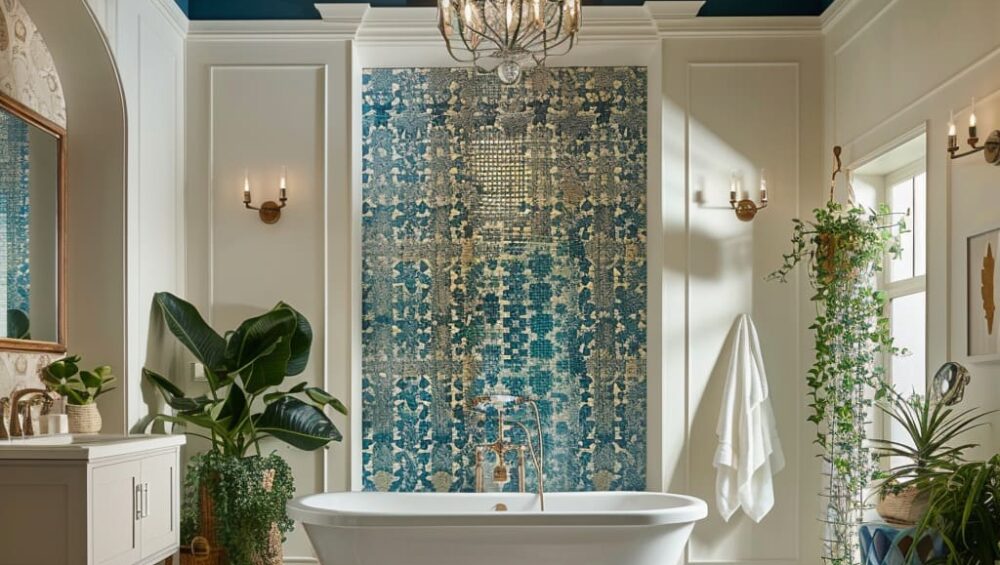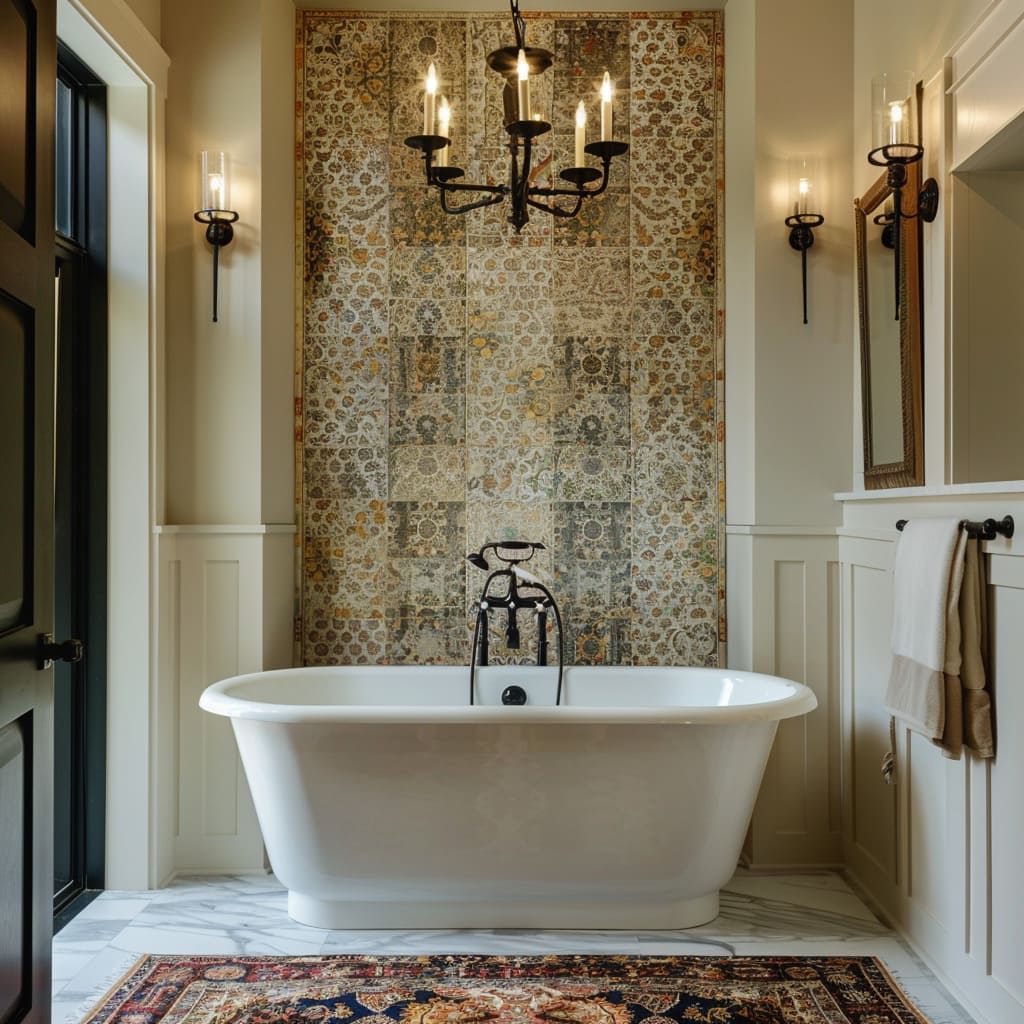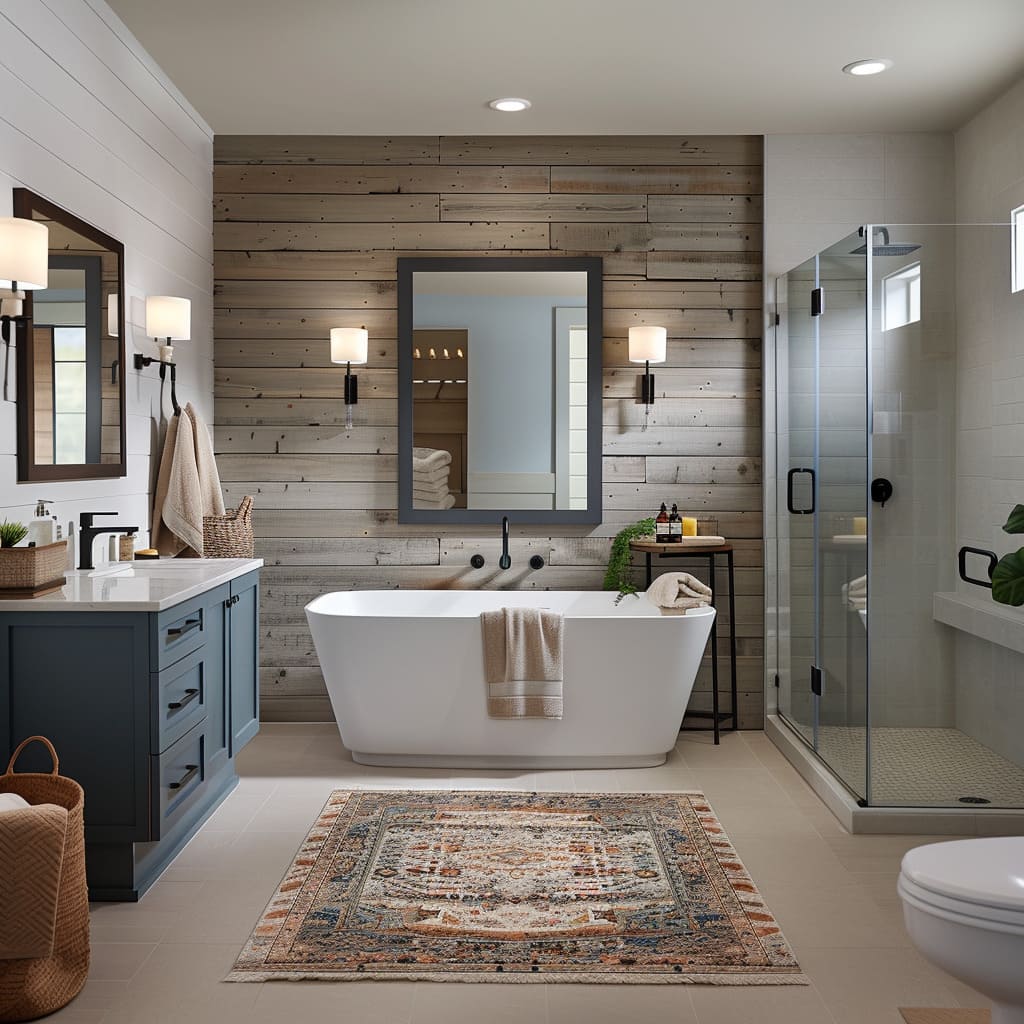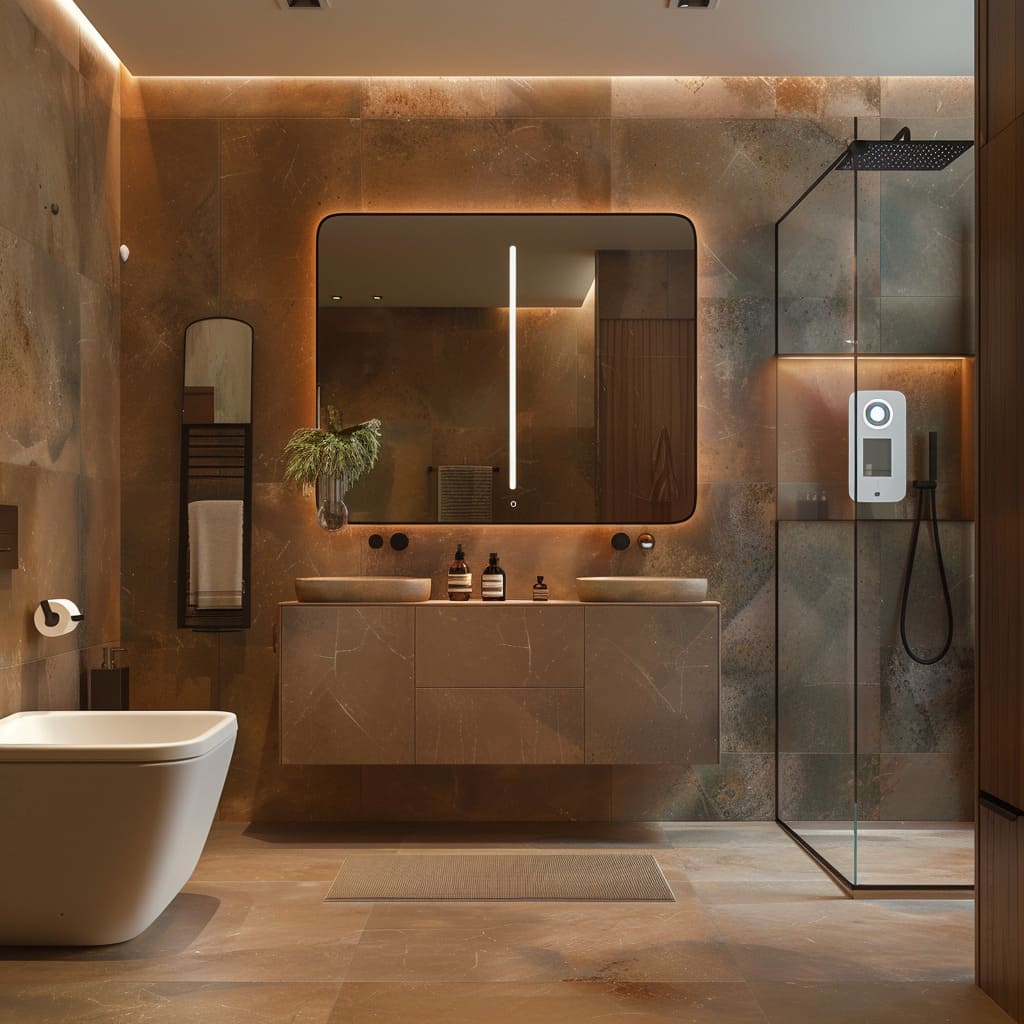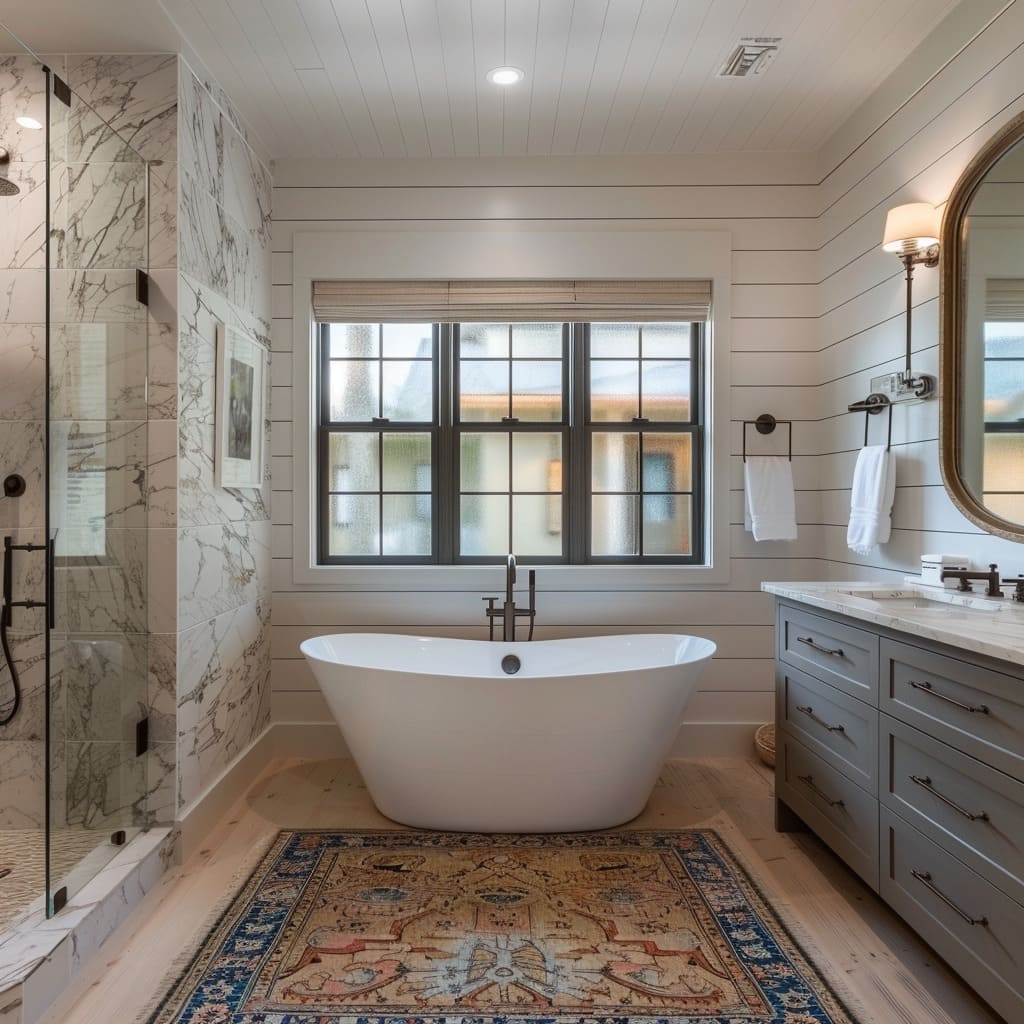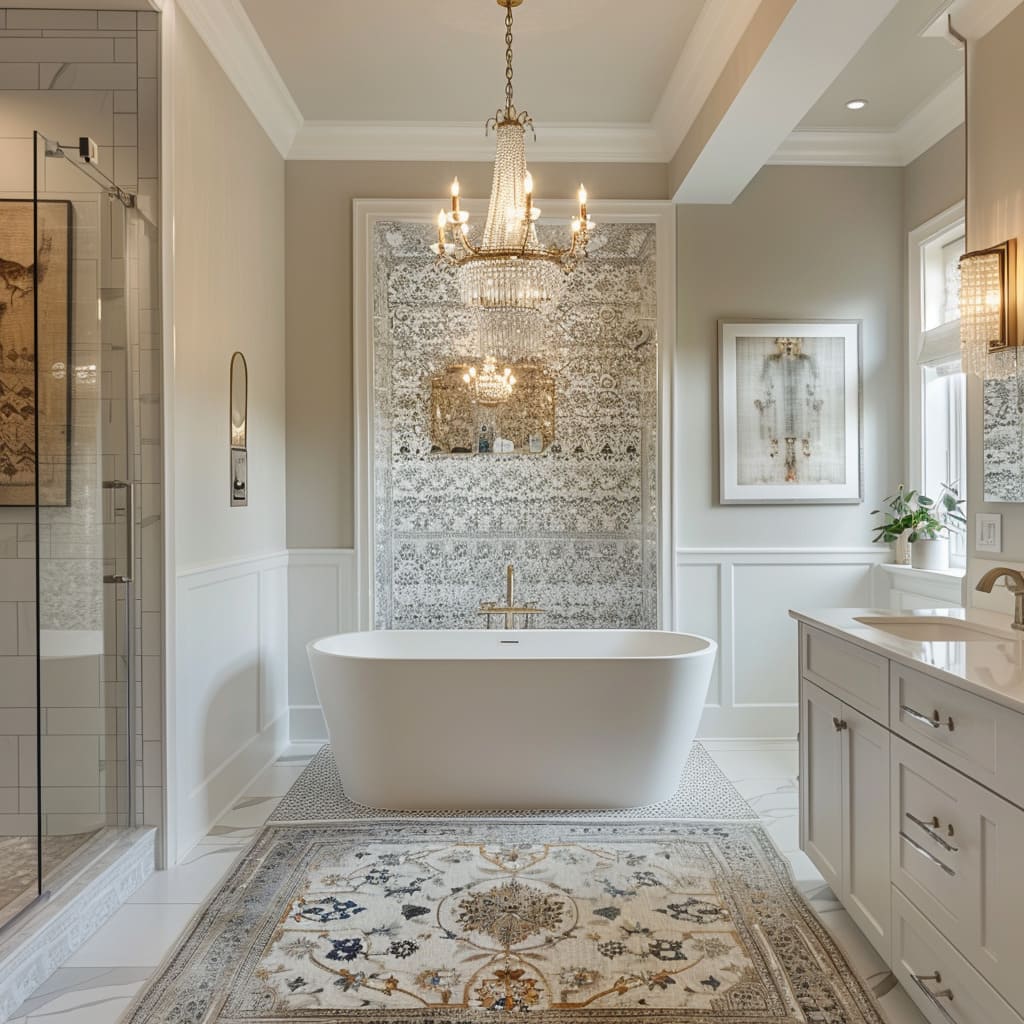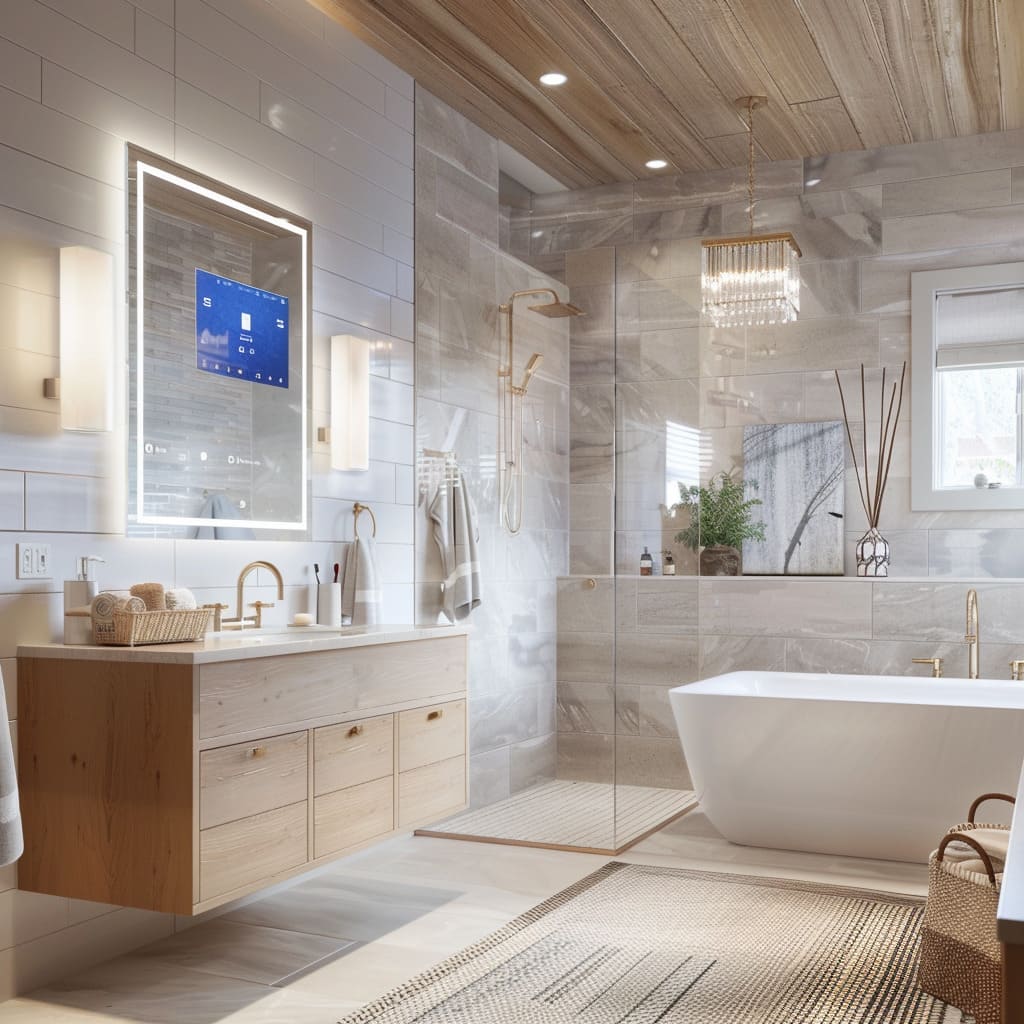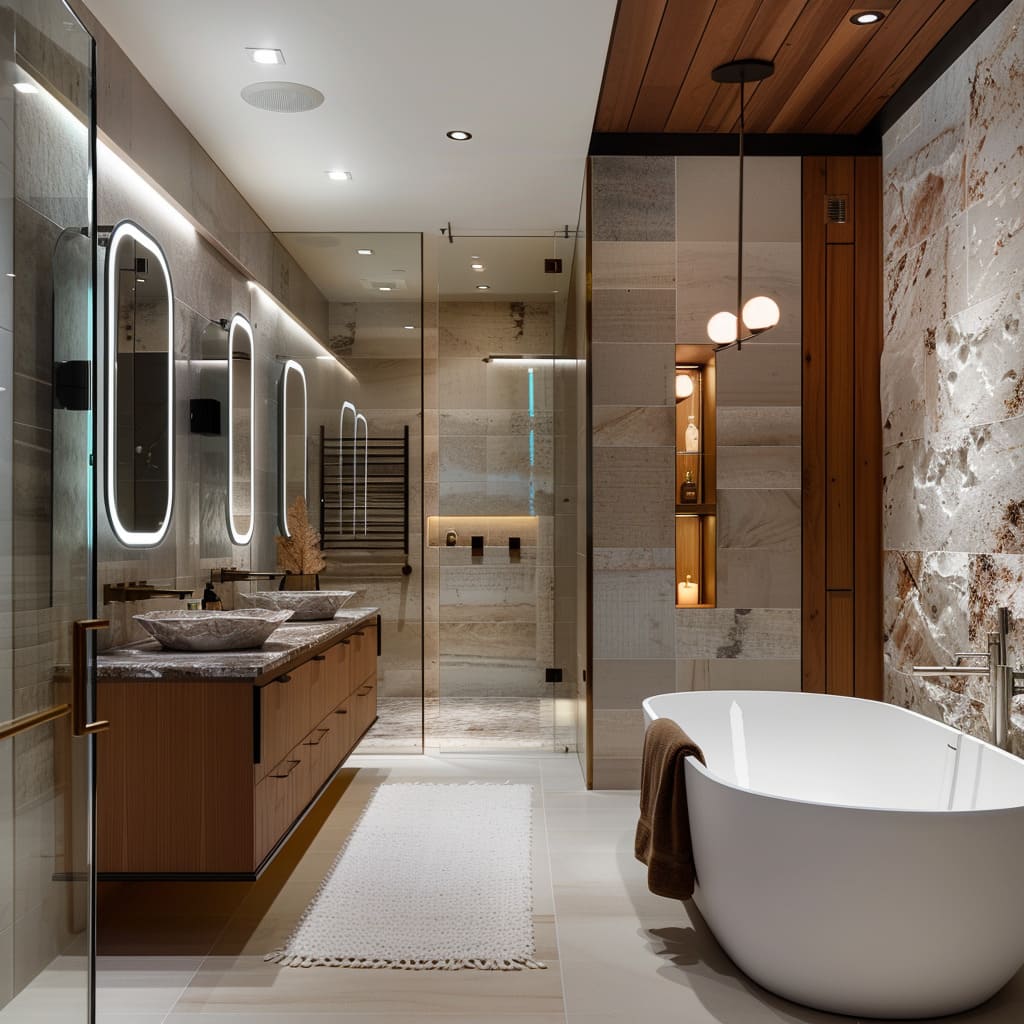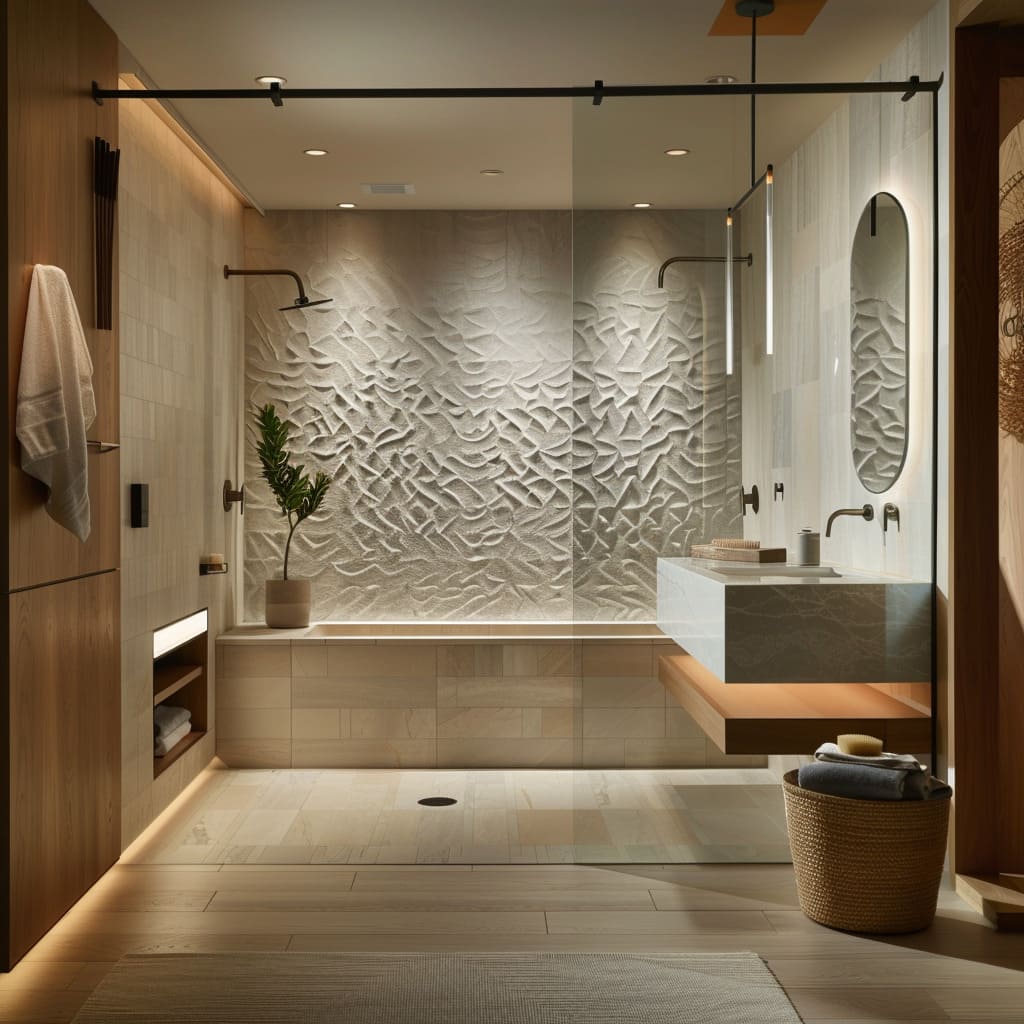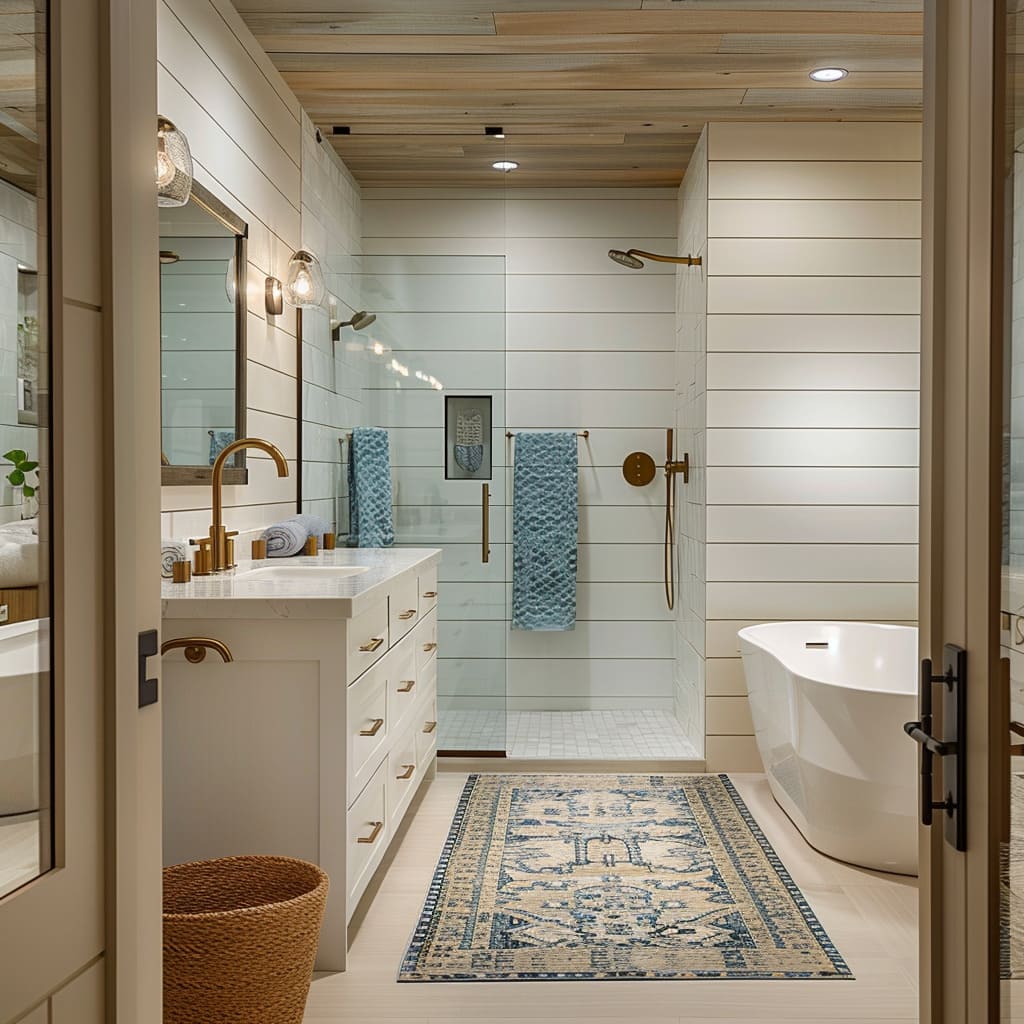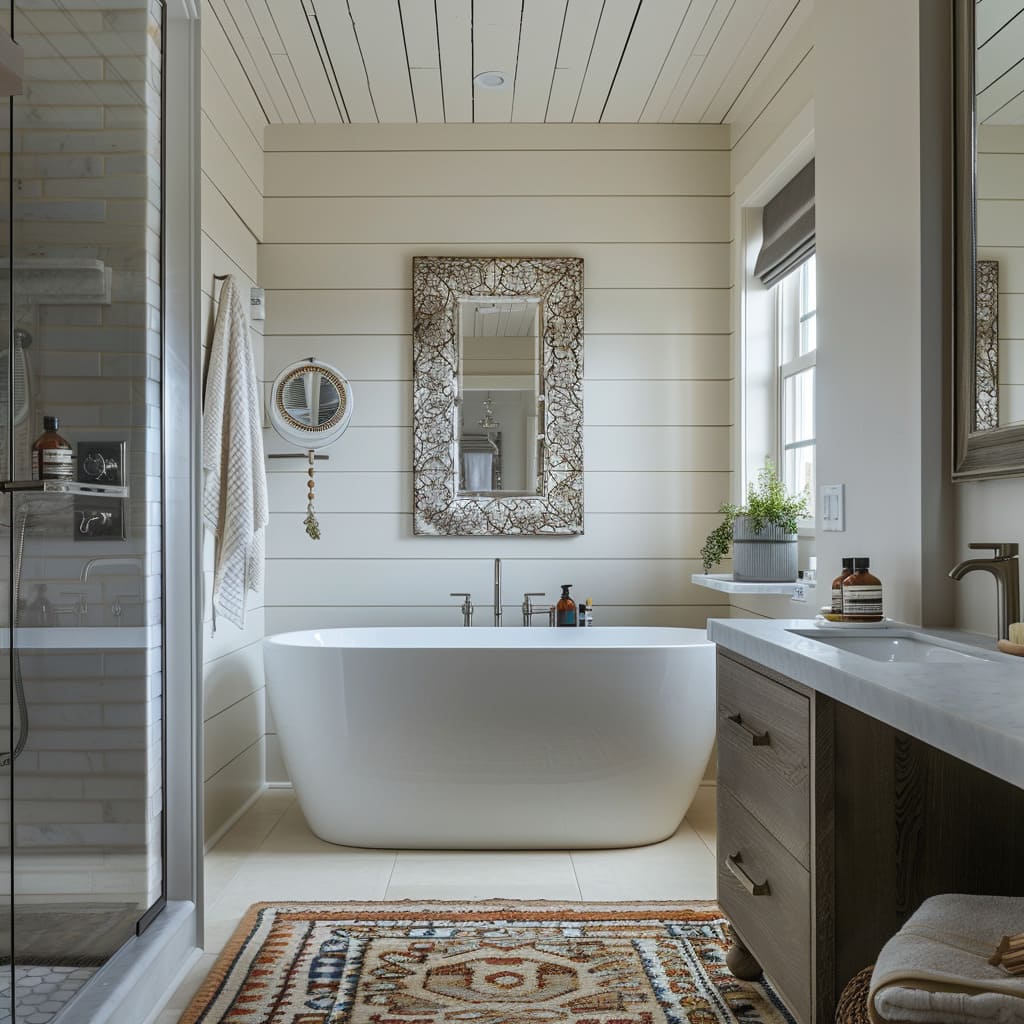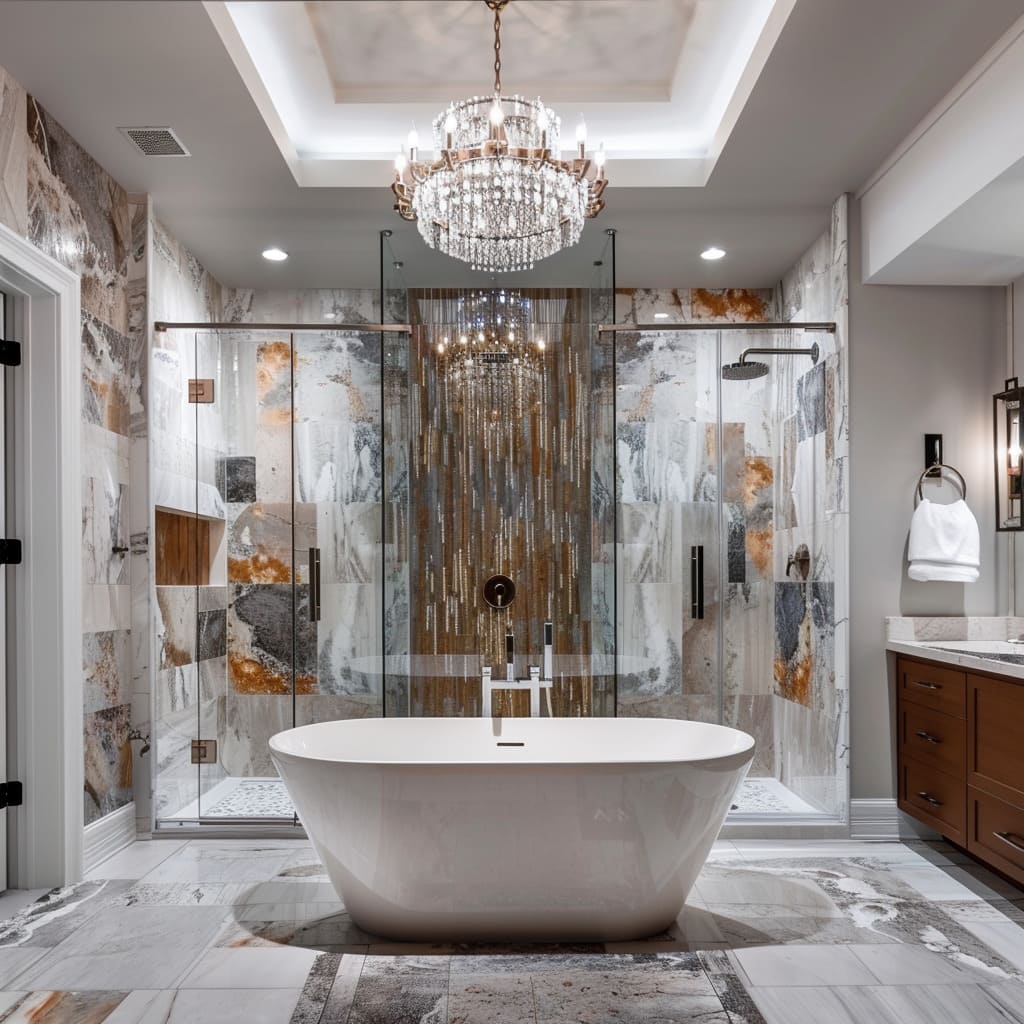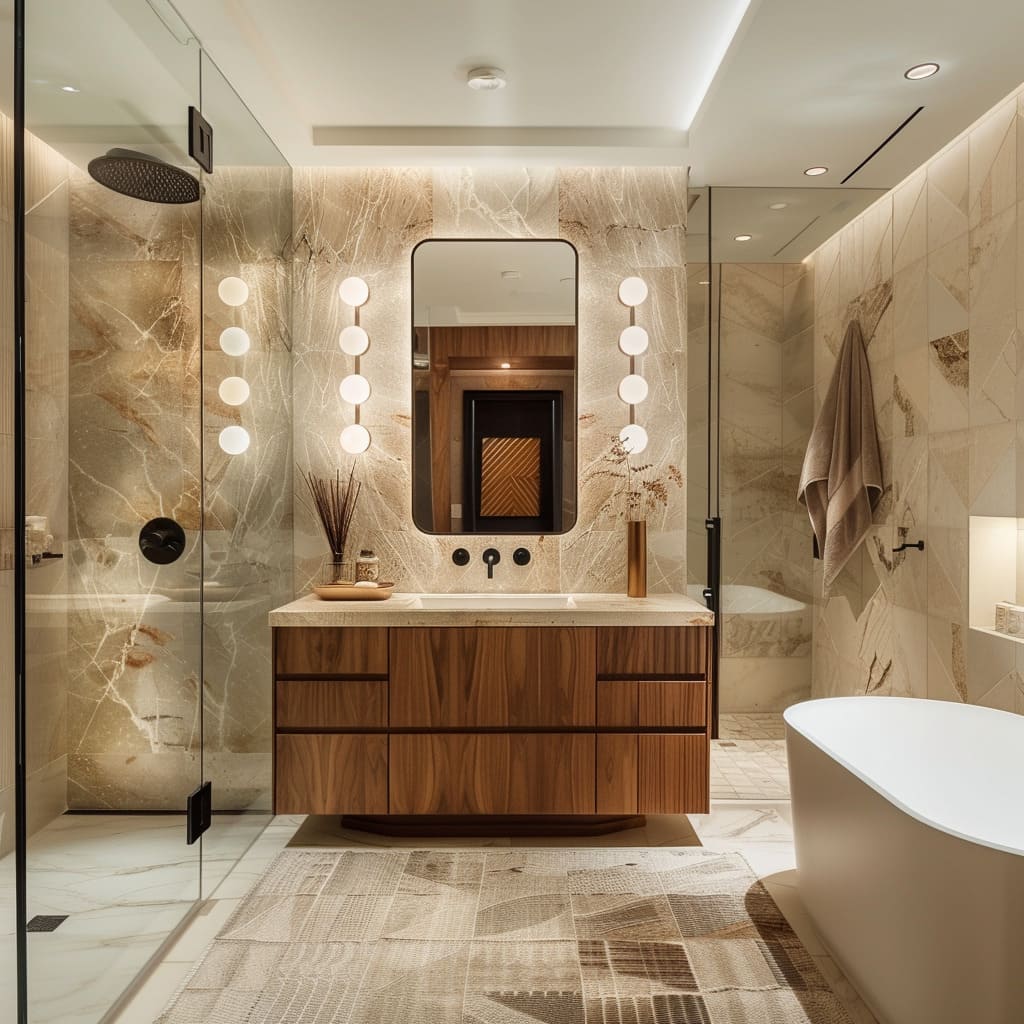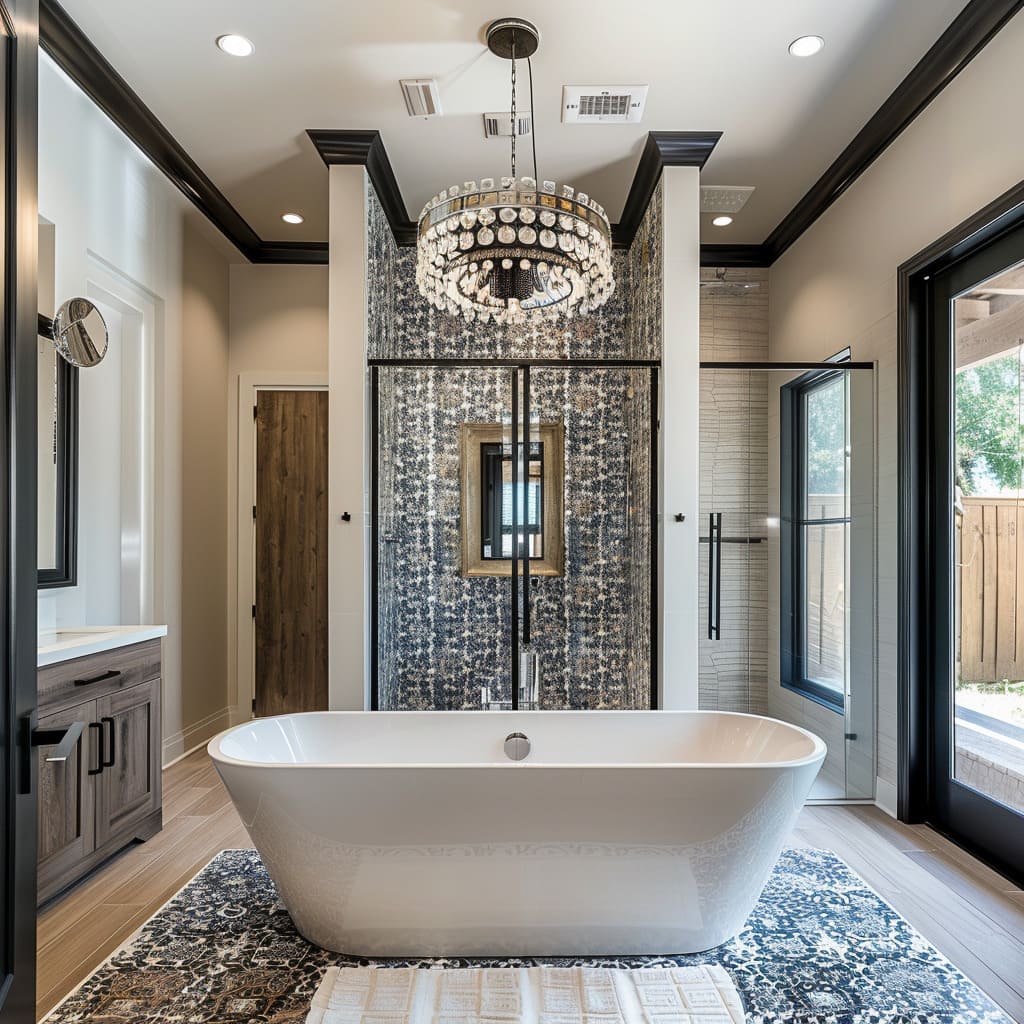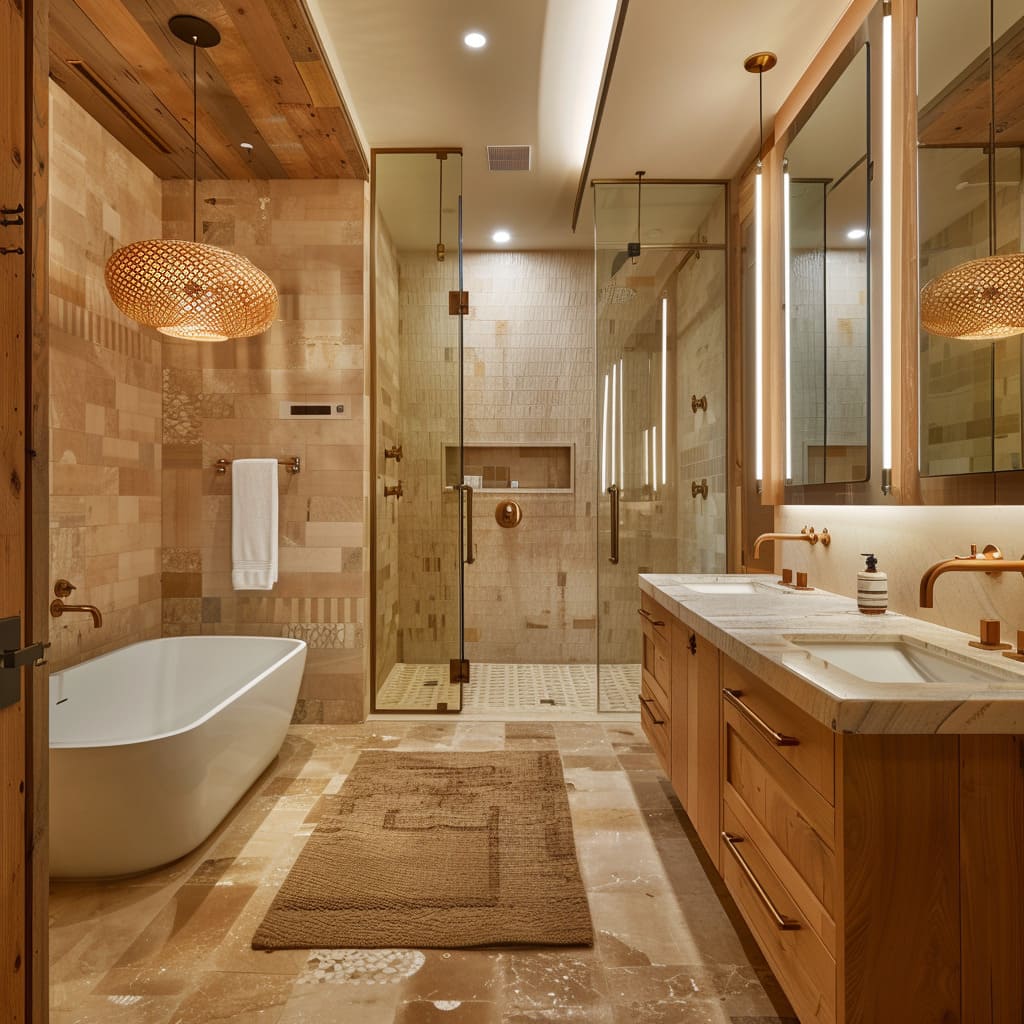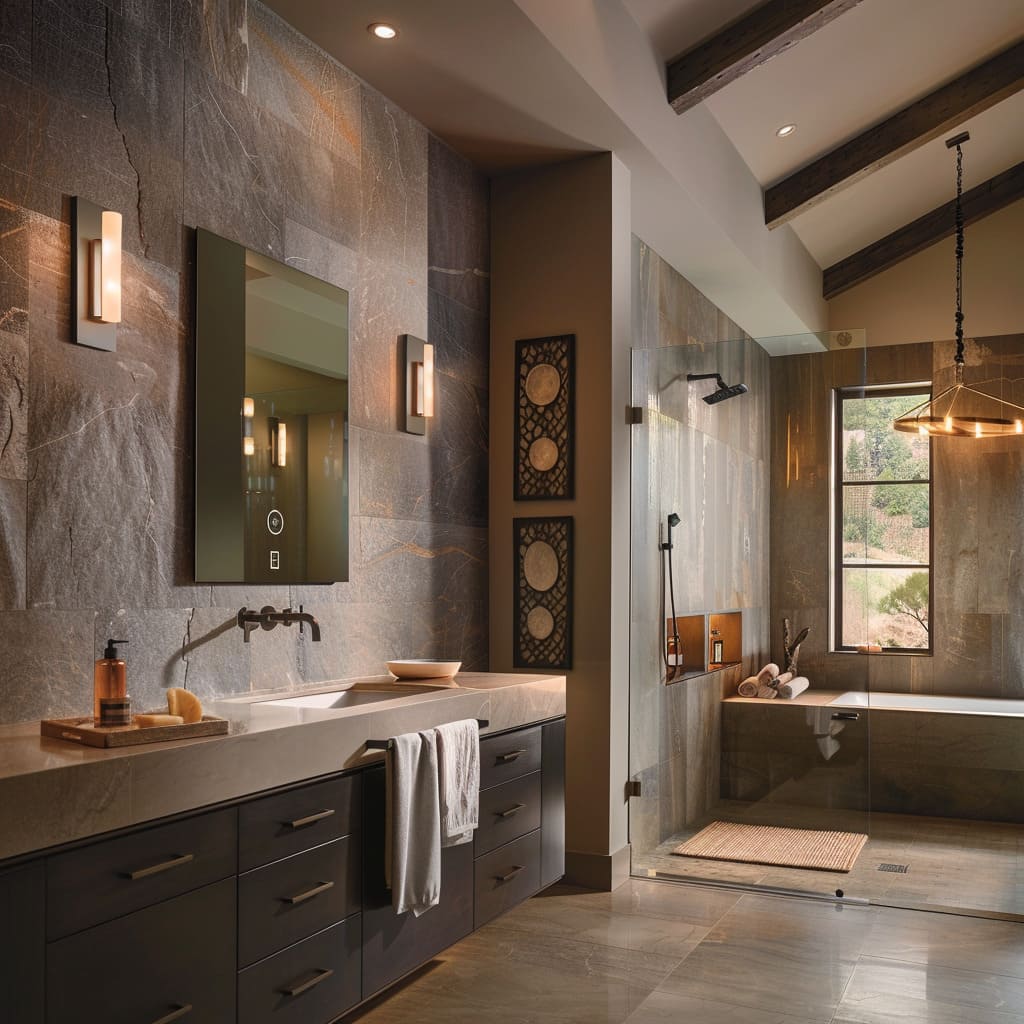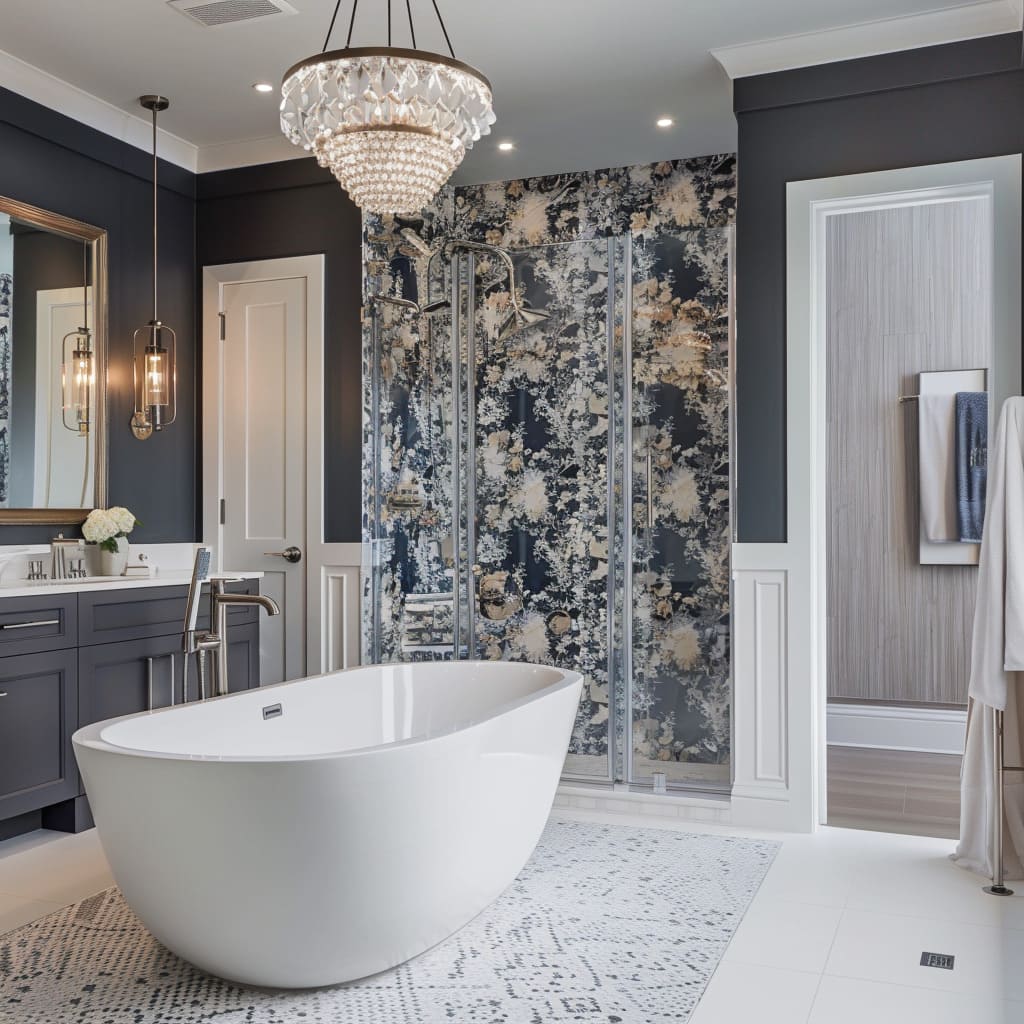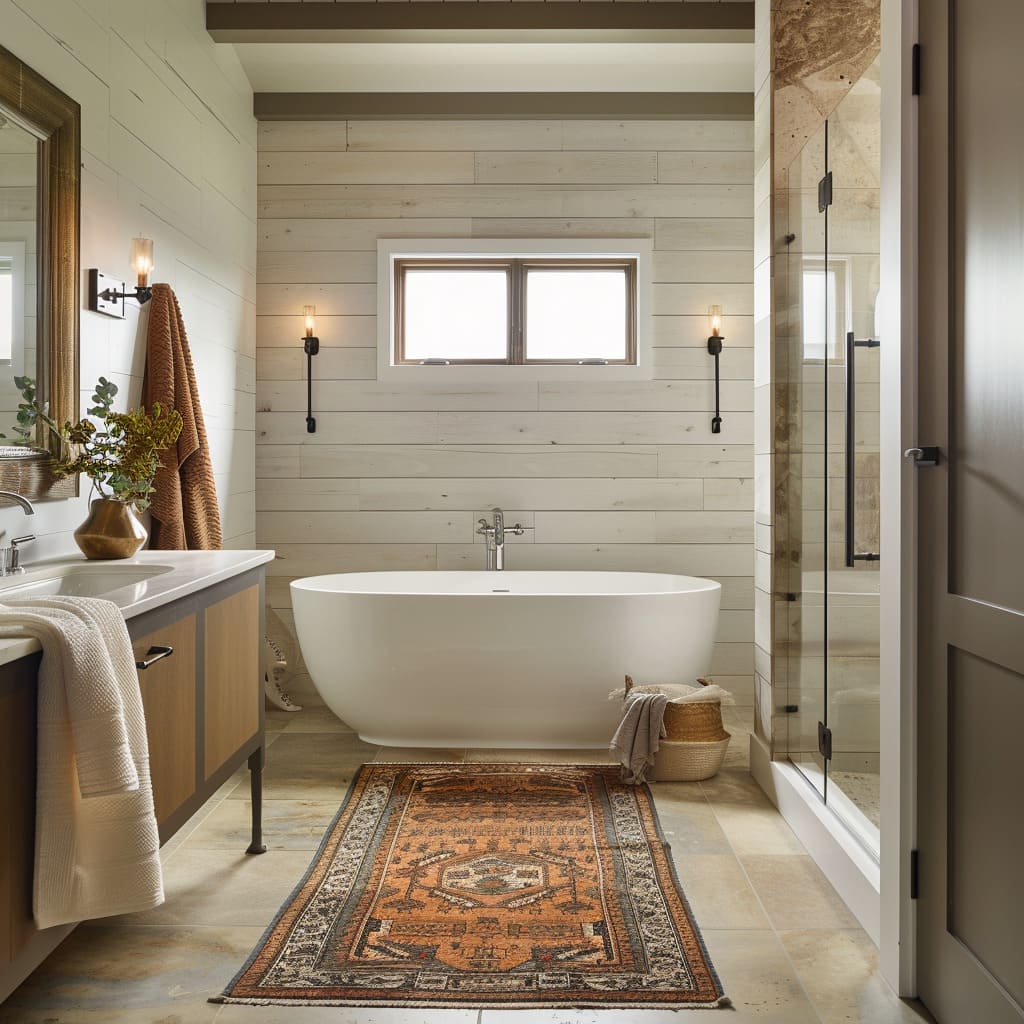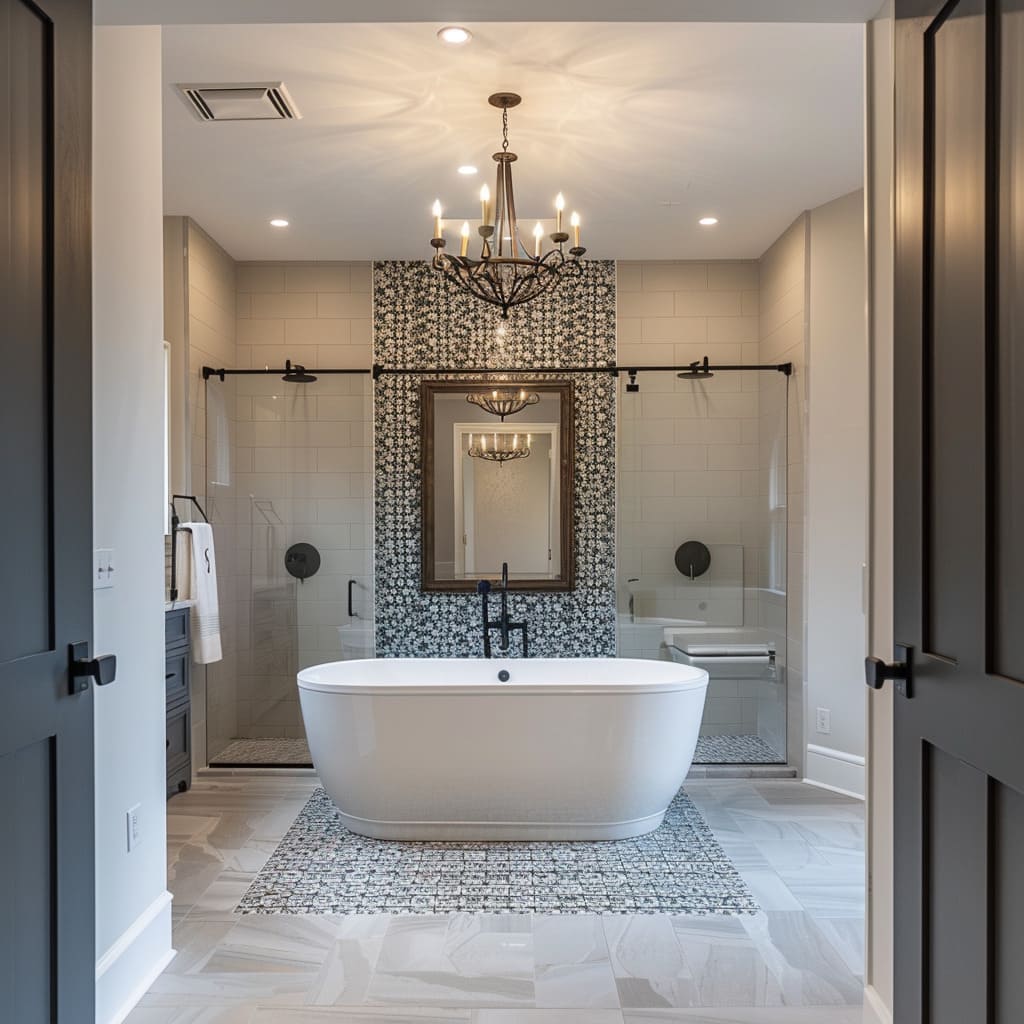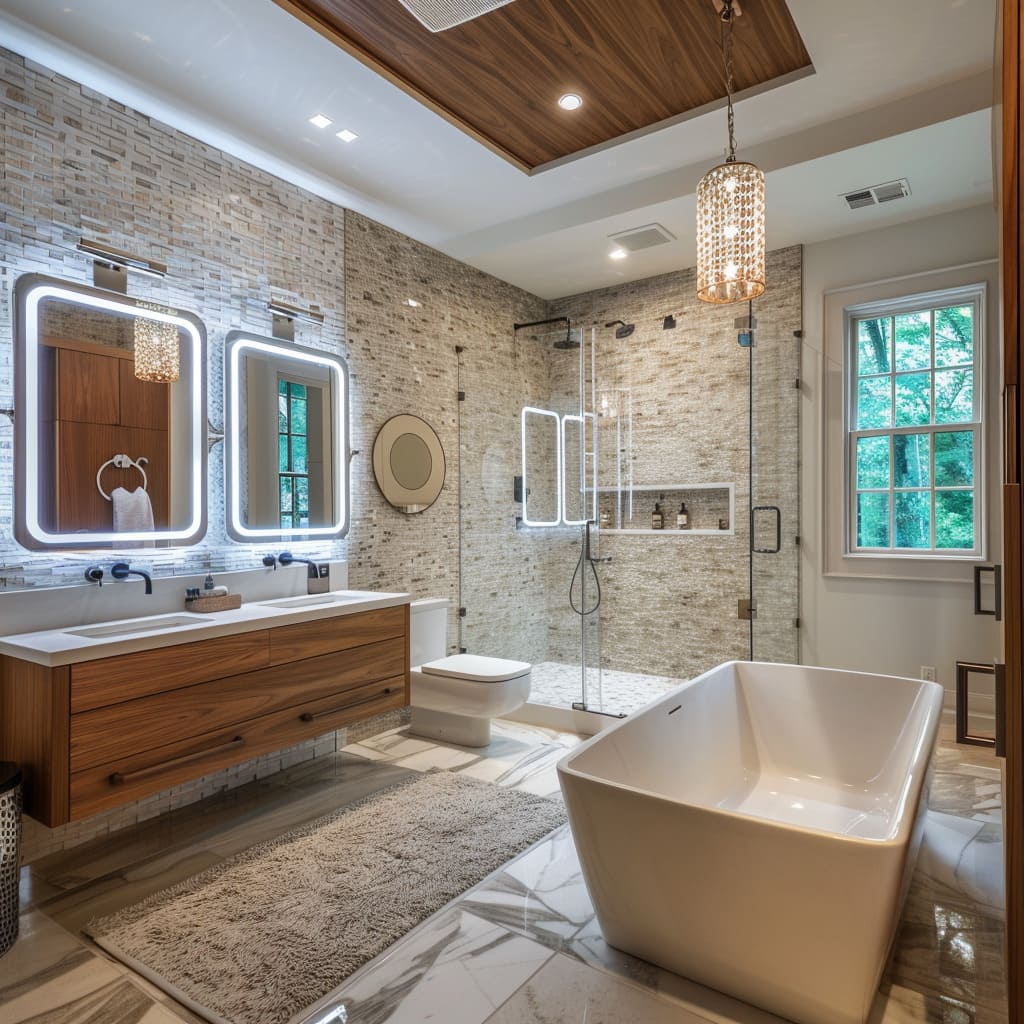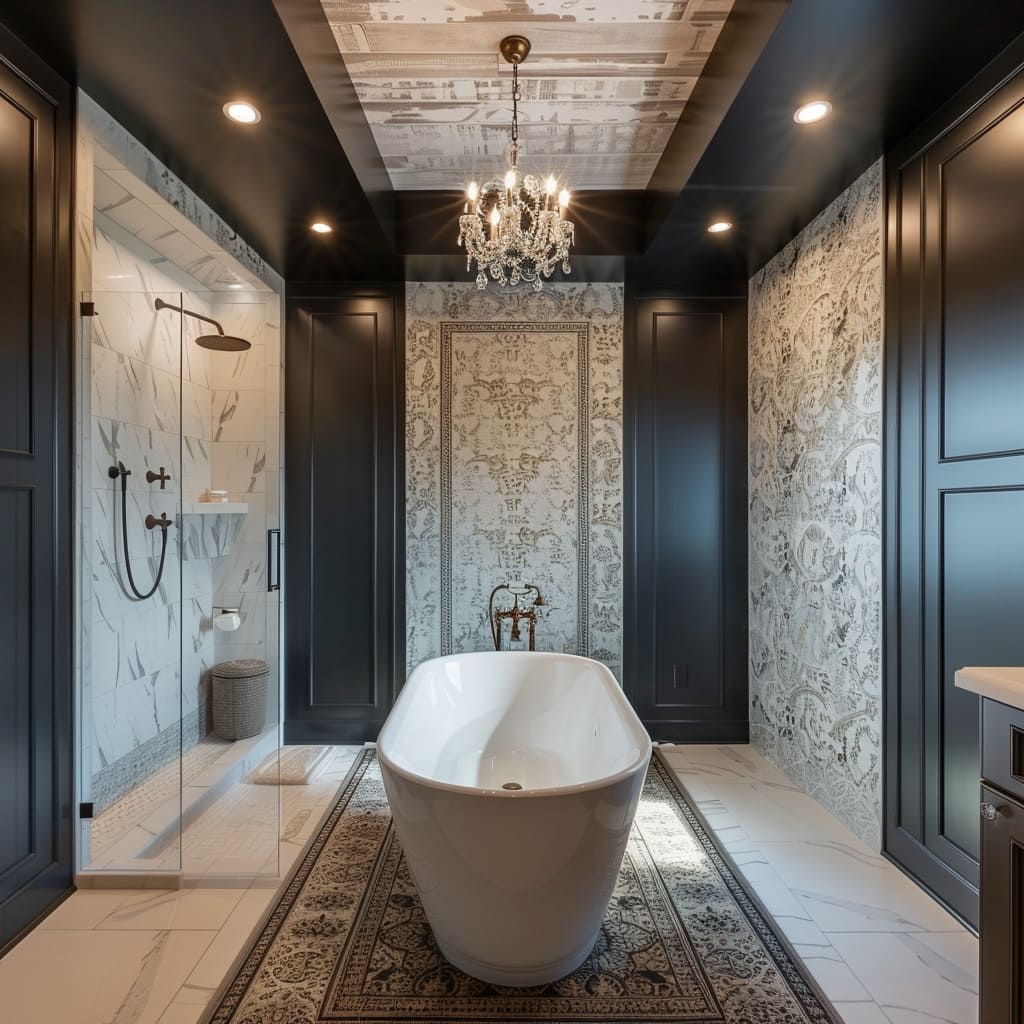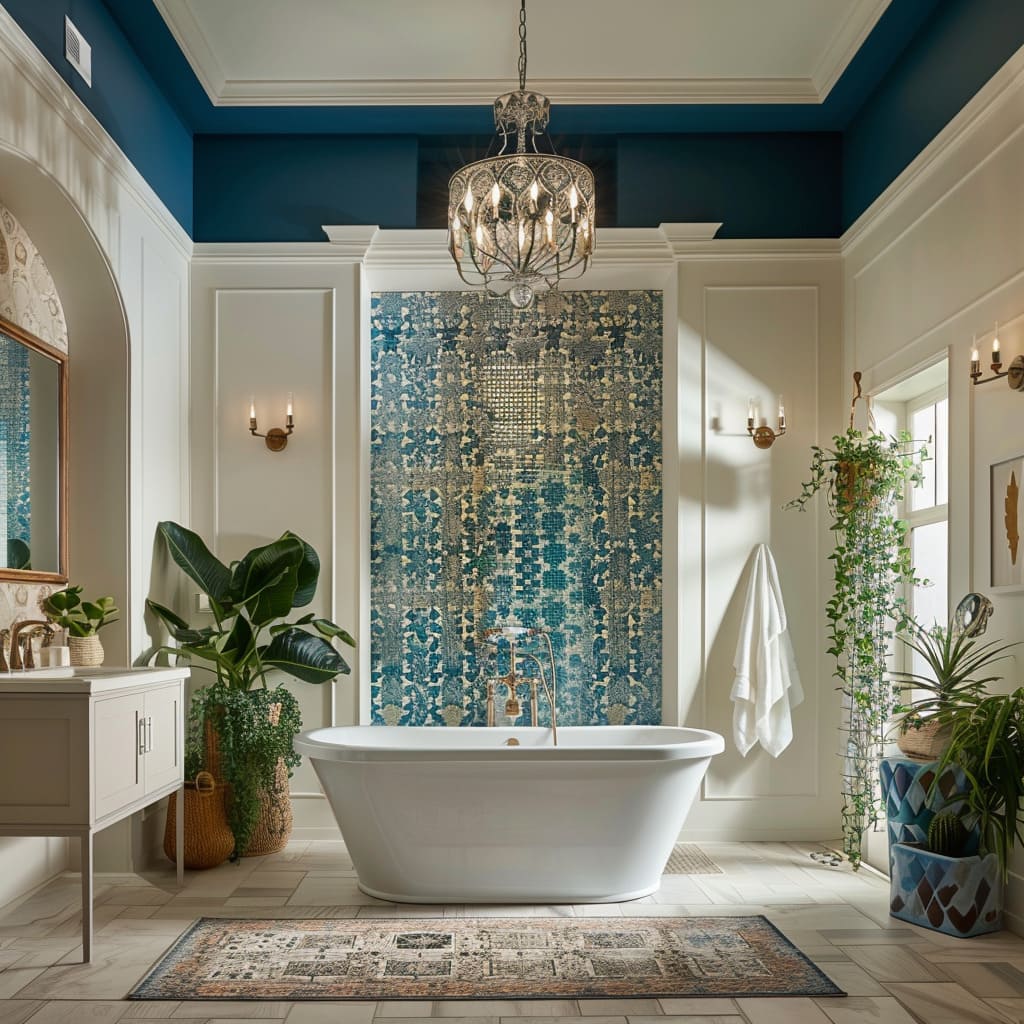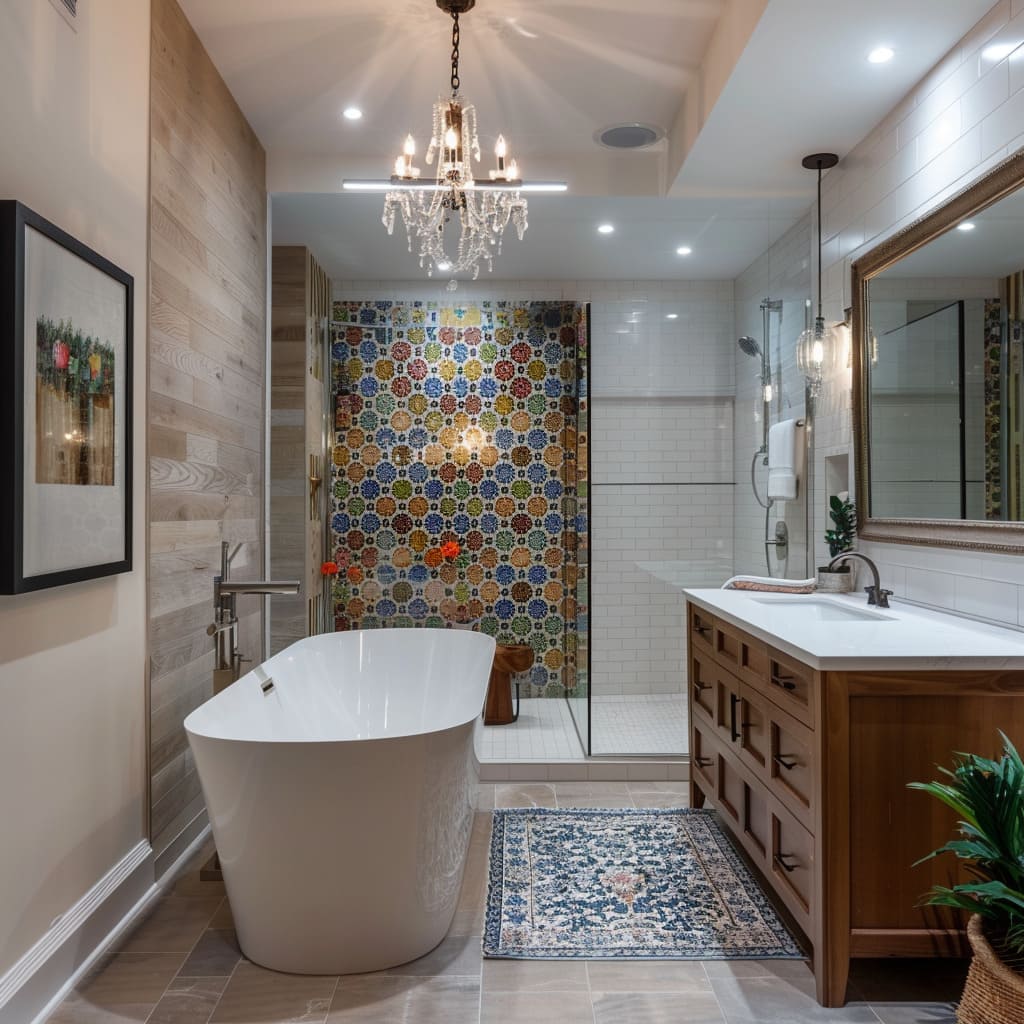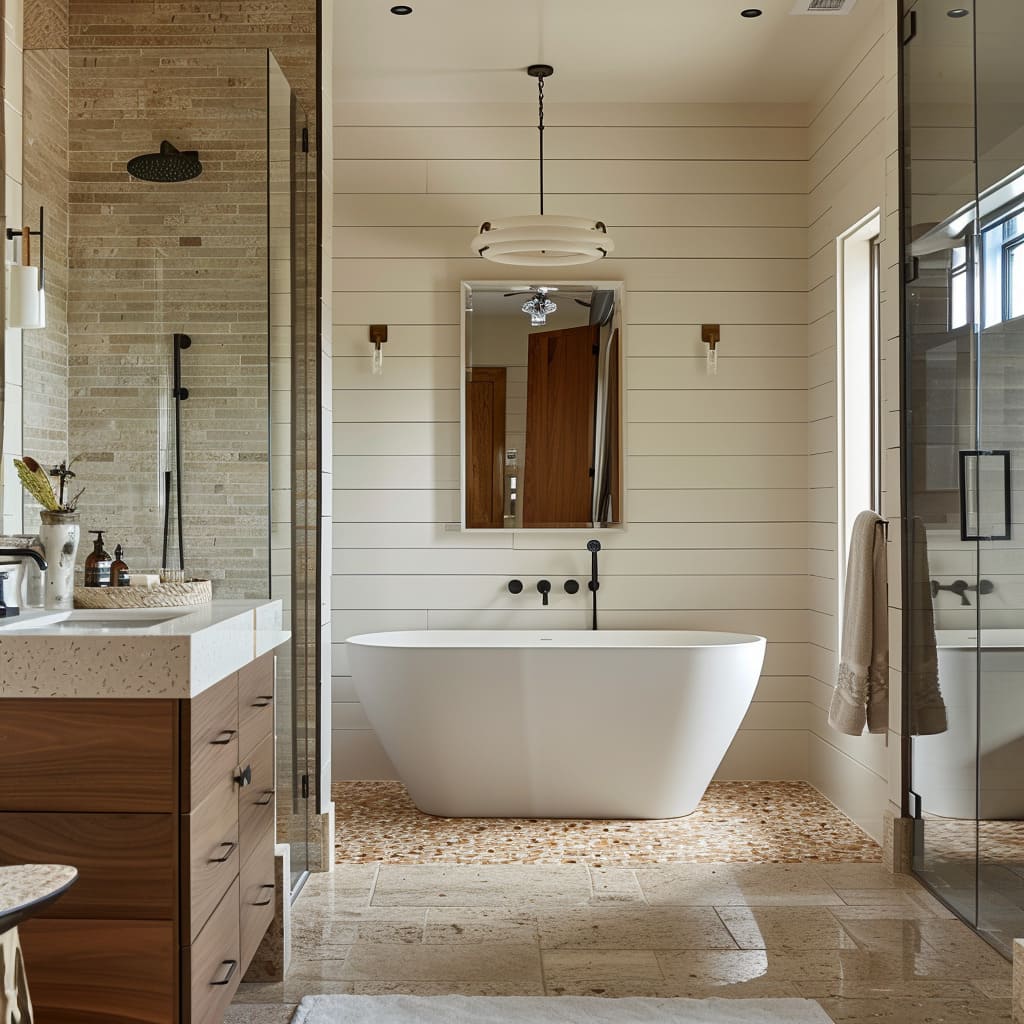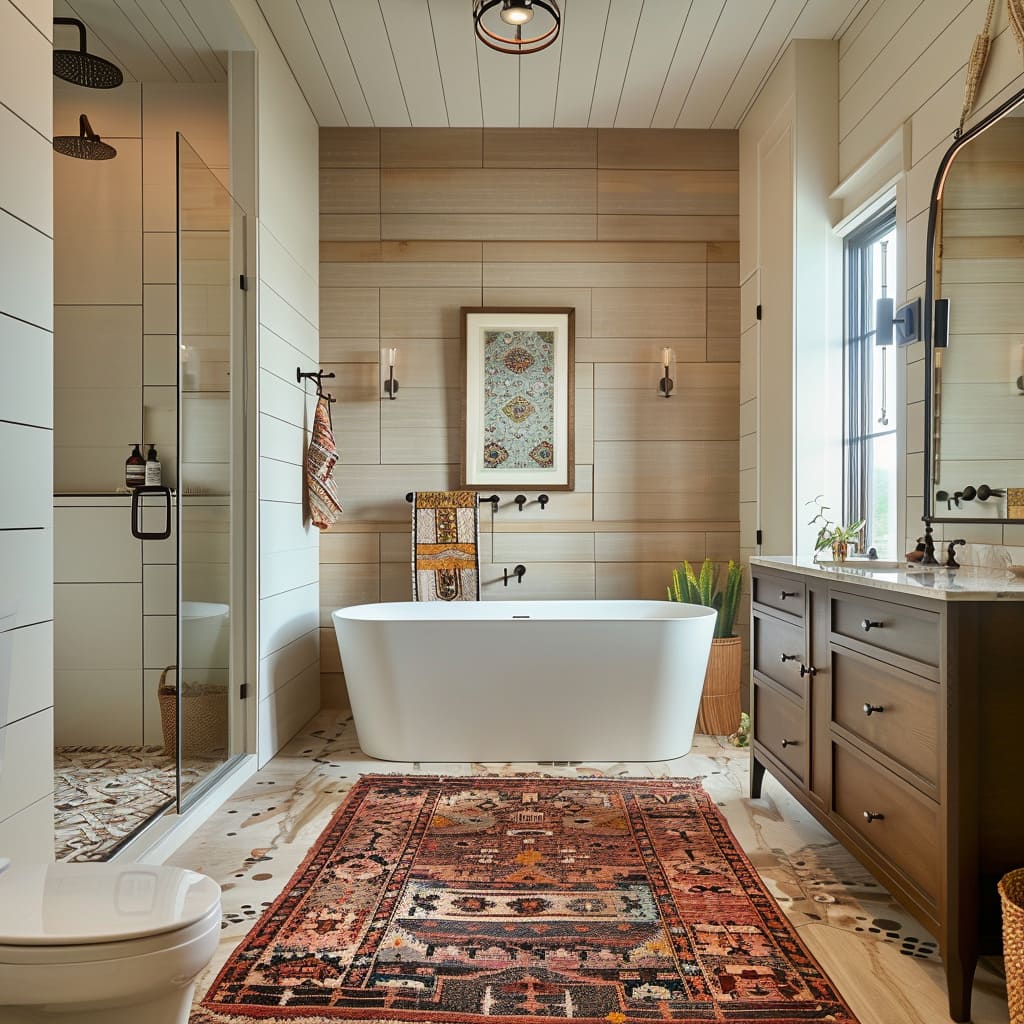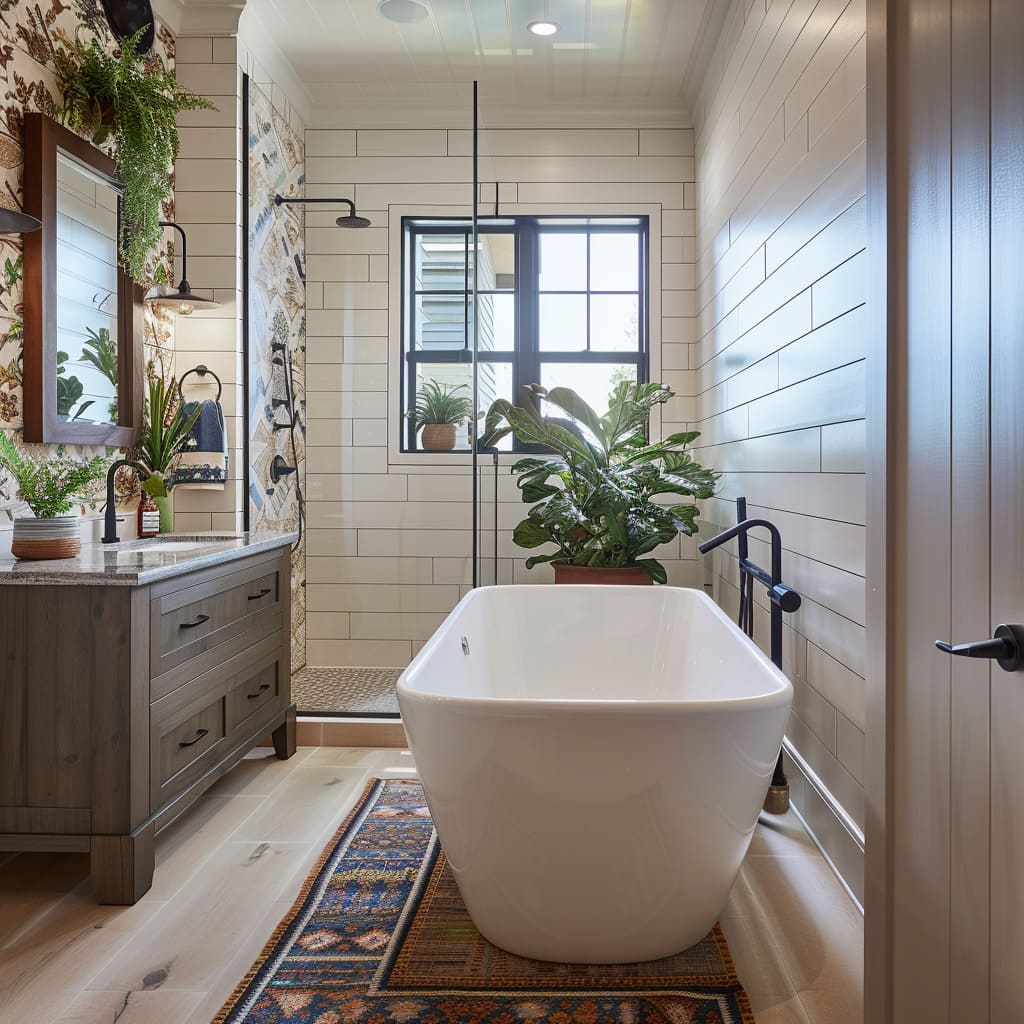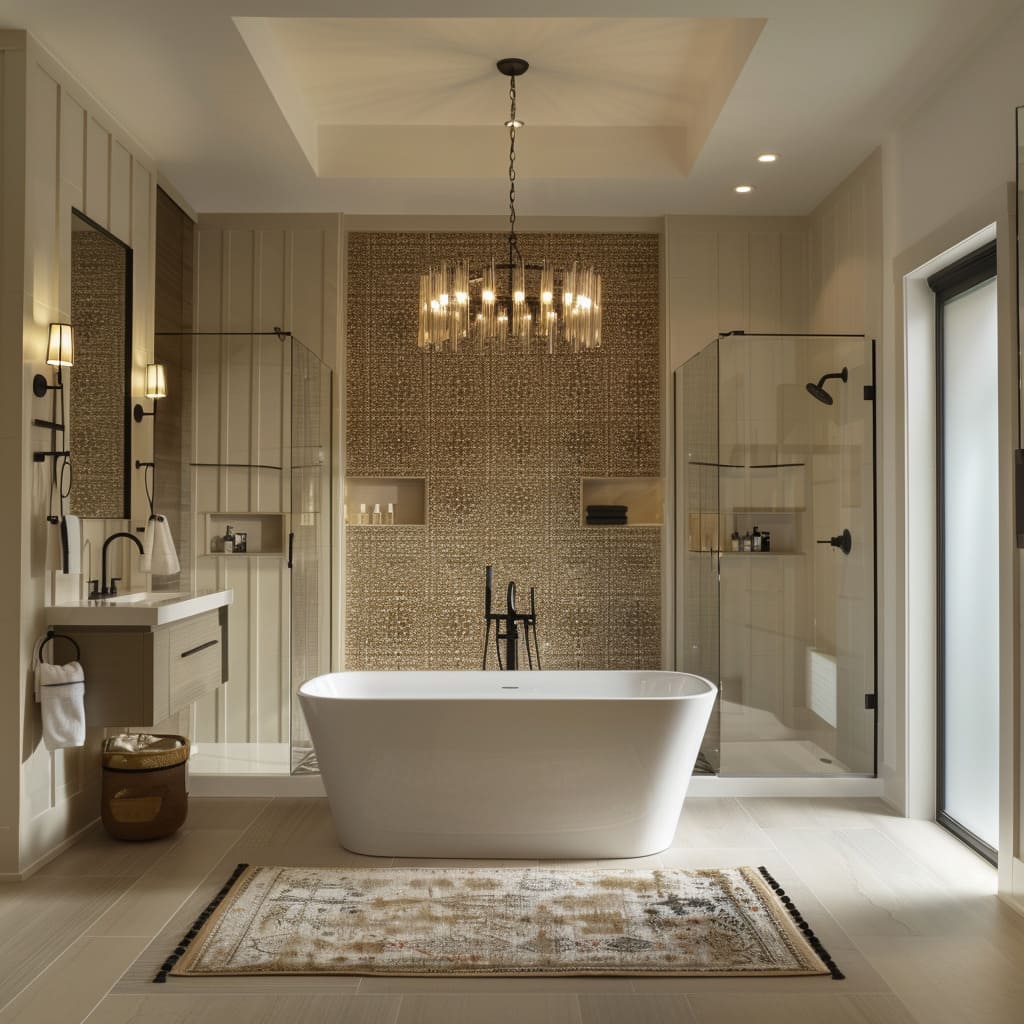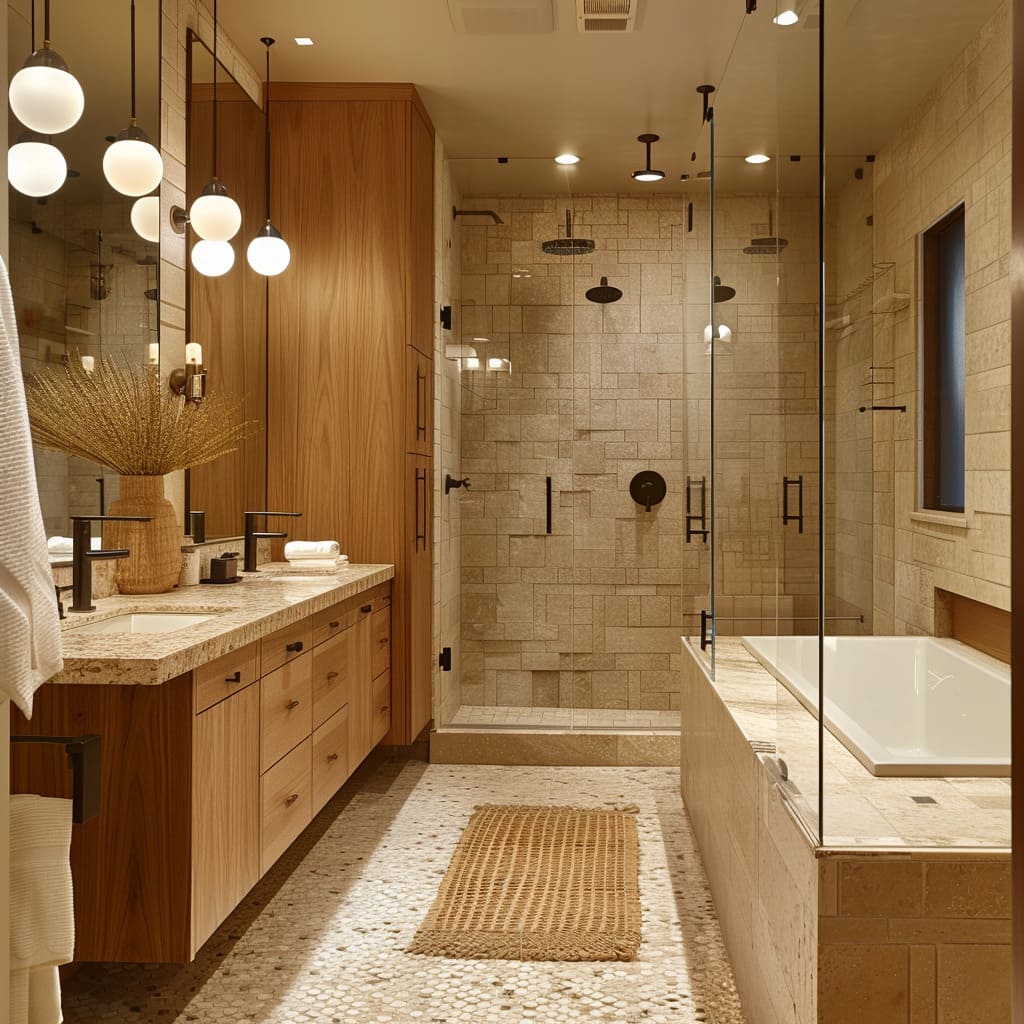In the tapestry of modern American home design, bathrooms have emerged not merely as functional spaces but as bastions of style and personal sanctuary. The contemporary American bathroom blends innovative technology with aesthetic sophistication to create an experience that caters to both the demands of daily life and the desires for personal retreat and relaxation.
This article presents a detailed analysis of the main characteristics that are defining bathroom interior design trends across the United States. Each facet, carefully woven into the fabric of design, stands as a testament to the evolving ways we interact with and find respite within our personal spaces.
Aesthetic Cohesion and Adaptability
Adaptive Elegance: The Art of Aesthetic Flexibility and Focal Symmetry
In this section, we focus on the aesthetic elements that allow homeowners to adapt their spaces to current trends while maintaining a timeless elegance. We’ll look at the use of versatile color accents that can easily be changed and modular elements that offer flexibility in design.
The strategic placement of a striking bathtub as a focal point and discreet fixtures that streamline the visual experience exemplify how design elements can create a cohesive and adaptable space.
Customized Detailing
Custom details are a hallmark of personal taste and sophistication in modern American homes. Homeowners are selecting unique feature walls with intricate mosaic designs that serve as both an artistic statement and a personal signature.
The careful choice of cabinet handles and custom-designed mirrors are not merely functional but are reflections of individual style. Lighting, too, becomes an art form with installations that transform the illumination of space into an experience.
These customized details resonate with the desire for a space that is not only visually pleasing but also a true representation of one’s personality and taste.
Durable Surfaces
The surfaces in these bathrooms are chosen not just for their initial appeal, but for their longevity and ability to maintain their appearance over time. Composite stone, treated woods, and other robust materials are favored for their durability and resistance to the wear and tear of daily life.
This practicality speaks to a broader trend of valuing long-term satisfaction over short-term aesthetics, reflecting a mindset that cherishes sustained quality and functionality.
Versatile Color Accents
In a landscape where design trends shift rapidly, versatility in color is paramount. Accents that can pivot with changing tastes are a key feature, allowing a room to be transformed with simple updates.
Towels, accessories, and lighting can inject a splash of current trends into a neutral backdrop, offering a flexible approach to keeping the space contemporary without frequent overhauls. This adaptability to trends, with minimal effort, is highly valued in the fast-paced lifestyle of the U.S.
Modular Elements
The inclusion of modular design elements caters to a need for flexible living spaces. As lifestyles change, so too can the bathroom, with components that can be updated or replaced with ease.
This approach minimizes the need for extensive remodeling projects, providing a smart solution for those who seek to keep their homes in step with their evolving needs without the commitment of a full renovation.
Bathing as a Focal Point
The bathtub, especially when freestanding, is not just a fixture but a statement piece.
It anchors the room, drawing the eye and serving as a luxurious escape within the confines of the home. This emphasis on the bathtub as a key element of bathroom design is indicative of a broader shift towards creating personal sanctuaries—a place where one can retreat from the rapid pace of daily life.
It’s a reflection of the increasing importance of self-care and relaxation in the American lifestyle.
Personalized Technology and Efficiency
Intelligent Luxury: Marrying Personalization with Eco-Conscious Efficiency
In an age where technology seamlessly integrates into every aspect of our lives, bathrooms have transformed into personalized havens of efficiency. This section delves into the convergence of smart home integration, such as voice-activated controls, with the practicality of water-saving fixtures.
The emphasis here is on intelligent design that celebrates individual preferences while being mindful of environmental responsibilities. From showers that remember your temperature preferences to toilets that economize water usage, this union of technology and efficiency is a defining trend in U.S.
bathroom interiors.
Efficient Water Fixtures
The drive towards environmental responsibility has become a central theme in American homes, leading to the adoption of water fixtures designed to reduce consumption. Faucets, showers, and toilets that use less water represent a commitment to conservation, aligning with the broader ethos of sustainability.
This trend is a reflection of a society that values resources and looks to integrate responsible practices into everyday life. In addition, these fixtures often come with sleek designs that do not compromise the bathroom’s aesthetic appeal, marrying function with form.
Smart Home Integration
The intersection of convenience and modern living is epitomized by the integration of smart technology in the bathroom. Automated lighting systems that adjust to the time of day, voice-activated commands that start showers at the perfect temperature, and mirrors that double as information hubs are no longer futuristic dreams but present-day realities.
This adoption of smart technology underscores a broader trend of seeking convenience and personalization in every room of the house. In the context of the bathroom, it transforms routine into ritual, making every interaction with the space a bespoke experience.
The growing trend in the U.S. towards smart homes reflects a cultural embrace of innovation that simplifies and enhances daily routines.
Comfort and Accessibility
Inclusive Comfort: Designing for a Universal Experience
Comfort and accessibility are at the forefront of modern bathroom design, creating spaces that are not only luxurious but also universally accessible. This section will explore how the concept of ‘aging in place’ is influencing design choices, making bathrooms safer and more comfortable for individuals at all stages of life.
We’ll look at the incorporation of heated elements for added comfort and advanced ventilation systems for a fresh, spa-like atmosphere. Bathrooms are being transformed into retreats that cater to physical comfort and ease of use, ensuring longevity in design.
Heated Elements
The quest for comfort in the American home has led to the adoption of heated elements in the bathroom, a luxury once reserved for high-end establishments now becoming more mainstream. Heated floors invite bare feet even in the chilliest weather, transforming the bathroom experience into something warm and welcoming.
Towel racks that radiate warmth not only offer the cozy embrace of a pre-warmed towel but also serve to quickly dry towels, reducing moisture and the potential for mildew. This trend speaks to a desire for daily indulgence and the prioritization of comfort in home design.
Advanced Ventilation
Maintaining a fresh atmosphere within the bathroom is not only a matter of comfort but also health. Sophisticated ventilation systems are thus an integral feature in modern bathrooms, rapidly extracting steam and odors to maintain optimal air quality.
These systems help to control humidity, protecting surfaces from moisture damage and ensuring the longevity of the bathroom’s aesthetic elements. The move towards such advanced systems reflects an understanding of the bathroom’s multifunctional role as a place for both rejuvenation and practicality.
Aging in Place Design
As the population ages, there is an increasing emphasis on creating spaces that can adapt to changing mobility and accessibility needs. Designing bathrooms with walk-in showers, benches, and handrails makes the space usable and safe for individuals at all stages of life.
This thoughtful approach to design aligns with a broader cultural shift towards inclusive spaces that accommodate a range of abilities, ensuring that the bathroom remains a functional and relaxing space for everyone, regardless of age or mobility. The integration of such features underscores a commitment to creating homes that can evolve with the needs of their inhabitants.
Sensory Experience and Wellbeing
Sensory Haven: Enhancing the Personal Retreat with Ambient Details
The modern bathroom goes beyond functionality, evolving into a sensory retreat aimed at enhancing wellbeing. This section will discuss how varying lighting options and acoustic considerations contribute to a bathroom’s ambiance.
The ability to adjust light levels to suit different moods or times of day, combined with materials that support acoustic privacy, underscores the bathroom’s role as a sanctuary for relaxation and rejuvenation.
Acoustic Considerations
In the pursuit of creating a serene haven within the home, special attention is given to the acoustics of a bathroom. The use of sound-dampening materials and thoughtful design works to create a barrier against the chaos that may reign outside, allowing the bathroom to serve as a tranquil retreat.
This focus on acoustic privacy underlines the growing importance of wellbeing in home design, recognizing the bathroom as a restorative space where one can retreat for peace and quiet. In the U.S., where homes are often sanctuaries from the fast-paced world, such acoustic refinements in design resonate with the desire to carve out quiet, stress-free zones.
Varied Lighting Options
Lighting plays a pivotal role in shaping the ambiance of a bathroom. The trend towards varied lighting options reflects a keen awareness of how illumination can influence mood and functionality.
Ambient lighting creates a soft glow that relaxes the senses, while task lighting provides clear visibility for grooming activities. Features like dimmers or color-temperature-changing lights offer the flexibility to alter the room’s atmosphere with ease.
This versatility is particularly trendy in the U.S. as it allows for a personalized experience tailored to the moment’s needs, whether it’s unwinding in a soothing bath or preparing for the day ahead.
Personal Care and Discretion
Tailored Sanctuaries: Integrating Personal Care with Discreet Design
This final section celebrates the incorporation of amenities and design choices that cater to personal grooming and care within the discreet sanctuary of the bathroom. With a growing desire for bathrooms to serve multiple functions, we examine the trend towards personal care amenities like built-in vanities and refrigeration units for beauty products.
Additionally, we consider how design elements such as discreet fixtures create a seamless and uncluttered space, reinforcing the bathroom’s role as a private and serene environment.
Personal Care Amenities
Personal care amenities have become an integral part of the modern bathroom, reflecting a broader trend towards self-care and wellness. Built-in vanities are designed to house appliances and makeup, offering a dedicated space for beauty routines.
These features are not only about aesthetics but also functionality, providing organization and ease of access. Small refrigeration units are another luxurious touch, keeping skincare products at optimal temperatures.
The inclusion of such amenities in home bathrooms speaks to a culture that values the ritual of grooming and the time spent on oneself.
Discreet Fixtures
The trend towards discreet fixtures is driven by a desire for a visually uninterrupted space that feels calm and orderly. Concealing the functional aspects of a bathroom, such as toilet tanks and plumbing, contributes to a more streamlined and visually appealing environment.
This movement towards hidden functionalities is particularly popular in the U.S., where the emphasis on sleek, clean lines in home design is reflective of a desire for simplicity and order amidst life’s complexities.
Innovative Shower Systems
In the realm of personal wellness, the shower has transcended its traditional role, becoming a center for relaxation and rejuvenation. Innovative shower systems with multiple heads offer a customizable experience, allowing individuals to create a spa-like atmosphere in their own homes.
Programmable temperature and flow settings ensure every shower is perfectly tailored to personal preferences, a luxurious detail that appeals to the U.S. market’s affinity for personalized comfort.
This demand for customized bathing experiences aligns with a broader shift towards home spa culture, reflecting the importance of personal well-being in today’s fast-paced society.
As we navigate through the fluid landscape of interior design, the modern bathroom stands out as a space where personal preferences align harmoniously with emerging trends. These spaces are no longer just utilitarian areas but are reflections of individual identity, technological progression, and a collective move towards sustainability and comfort.
The characteristics discussed in this article encapsulate the essence of American bathroom design trends: a blend of personalization, technological integration, adaptable aesthetics, and an unyielding commitment to comfort and wellbeing. This transformation of the bathroom into a sophisticated, multi-functional space mirrors the dynamic shifts in how Americans perceive and utilize their living environments.
As we look to the future, it is clear that the bathroom will continue to be a significant aspect of home design, ever adapting to the rhythms of modern lifestyles and the nuances of individual taste.

